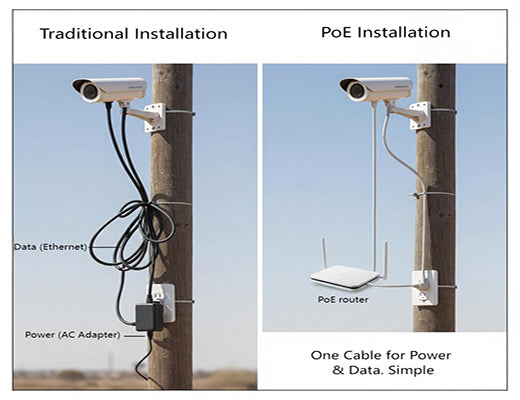
What is a PoE Router? A Guide to Simplifying Your IoT Deployments
|
|
Time to read 5 min
|
|
Time to read 5 min
A PoE router is a powerful, all-in-one network device that not only provides internet connectivity but also delivers electrical power over the same Ethernet cable to connected devices. This technology, known as Power over Ethernet (PoE), is a game-changer for IoT deployments. This guide explains what a PoE router is, how it dramatically simplifies installations for devices like IP cameras and Wi-Fi access points, and why choosing an industrial model with cellular backhaul and remote management capabilities is the key to building a truly reliable and cost-effective system.
A PoE router combines the functions of a network router, a network switch, and a PoE power injector into a single, compact device.
Its primary benefit is radically simplified installation: you only need to run one standard Ethernet cable to your end device to provide both a data connection and electrical power.
This technology is ideal for deploying devices in locations where power outlets are not readily available, such as remote security cameras, outdoor Wi-Fi access points, or VoIP phones.
A professional industrial PoE router adds critical features like a rugged design, reliable cellular backhaul (4G/5G), and the ability to remotely power cycle connected devices via a cloud platform.
I was talking to a security system installer recently, and he was describing his biggest headache: remote camera installations. He'd spend hours mounting a camera on a pole or the corner of a building, run the Ethernet cable for data, and then realize his job was only half done. He still had to hire an expensive electrician to run a separate, dedicated power line to the same spot. It was costly, time-consuming, and complex.
What if you could eliminate the electrician entirely? What if that single Ethernet cable could do both jobs?
Let's be clear: it can. The technology that makes this possible is called Power over Ethernet, and the device that brings it all together is the PoE router. This guide will explain what it is and why it's revolutionizing how we deploy connected devices.

A PoE router is simply a router that also acts as a PSE. Its Ethernet LAN ports are capable of delivering power to compatible devices.
The real 'aha!' moment for any installer or project manager is when they realize the immense benefits of this all-in-one approach:
While a basic PoE router is useful, an industrial PoE router is designed for mission-critical professional deployments. It adds three crucial layers of capability.

A PoE router is a powerful tool that simplifies deployments, reduces costs, and provides unmatched flexibility. When you choose an industrial PoE router like the Robustel R2120, you add the layers of rugged reliability, go-anywhere cellular connectivity, and game-changing remote management that are essential for any professional IoT monitoring or security system. It is the intelligent, all-in-one foundation for a truly modern and efficient deployment.
Learn more in our main guide:

A1: The Power over Ethernet standard allows for the transmission of power and data up to 100 meters (328 feet) over a standard Ethernet cable (Cat5e, Cat6, or better).
A2: Yes, it is perfectly safe. A PoE router is a smart device. Before sending power, it performs a "handshake" to check if the connected device is PoE-compatible. If it detects a non-PoE device like your laptop, it will only send data and will not send any power.
A3: The main difference is the amount of power they can deliver. The older PoE (802.3af) standard can provide up to 15.4 watts of power per port. The newer PoE+ (802.3at) standard can provide up to 30 watts per port, which is necessary for more power-hungry devices like pan-tilt-zoom (PTZ) security cameras or modern Wi-Fi 6 access points. A professional router like the R2120 supports both standards.